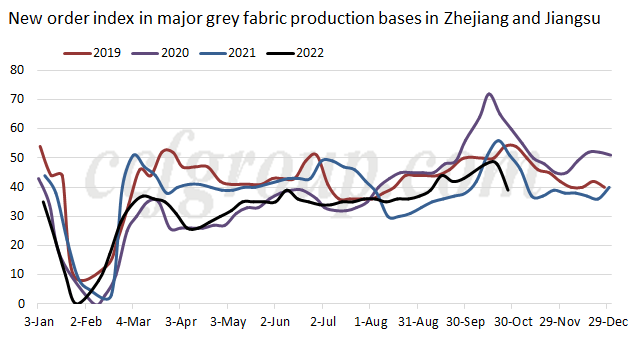Polyester downstream market witnesses slumping new orders amid worse pandemic
New orders for grey fabrics sharply dropped this week, especially those for knitted fabrics. Warp knitting and circular knitting plants who saw good orders previously expressed that new orders were reducing. Decreasing new orders were mainly due to the following major reasons: 1. The delivery in some wholesale markets like Dieshiqiao in Nantong and Zhongda in Guangzhou were stifled due to the pandemic. New orders were suspended. 2. The orders for the online shopping spree on Nov 11 came to an end. Seasonal demand softened. 3. Downstream players held weak mindset and were cautious in placing orders, worrying feedstock price to decrease further. 4. The temperature was moderate now, and the expectation of the cold winter reduced.

The operating rate of fabric mills also dived with substantially declining new orders and bearish anticipation toward feedstock trend, which moved down by 8 percentage points from earlier high to 66% by Oct 27. If orders continue slipping later, downstream plants may slash run rate further to avert risk.
Downstream demand is expected to weaken and the speed is fast amid the pandemic. The spread of pandemic is critical to the demand change, especially the pandemic control and prevention in some textiles wholesale markets. Seasonal demand may soften from Nov. Pessimistic view is held toward domestic sales and export of spring textiles and apparels near the Spring Festival holiday.
PFY companies discounted price successively in end-Oct, while sales improved limitedly. Price was not an issue now. Market players lacked confidence and faced supply/demand problem. Downstream buyers will continue replenishing only to cover the pressing demand no matter how much price is discounted. Stocks will be hard to fall even with price promotion. PFY companies may be pressed by price and profit. With ongoing high inventory and weaker demand, the only way-out for polyester companies may be the production curtailment before the end of year. If companies are not active in cutting output but being forced to slash production, the losses may continue and even expand.
The polyester polymerization rate was estimated at 84% on Oct 27, flatting with Oct 13. The polyester polymerization rate had some resilience when downstream plants saw stable business and run rate earlier but it will face bigger pressure when downstream business turns thinner and the operating rate of fabric mills starts descending. If downstream market remains weak, the polyester polymerization rate is expected to drop in Nov. The run rate change of leading PFY companies should be noted. In addition, polyester companies with 200-400kt/year of capacity are estimated to confront bigger pressure if downstream plants' run rate dips.
- Top keywords
- Cotton Price
- Cotton Futures Price
- Cotton Futures
- CZCE
- PTA Futures Price
- Chemical Fiber
- Polyester Prices
- Wool price
- PTA Futures
- Shengze Silk
- China
- Yarn Price
- price
- China Textile City
- Fibre Price
- Benzene Price
- Cotton
- Index
- Cotton Index
- PTA
- fabric price
- NYMEX
- Top 10
- textile industry
- Spot Cotton
- Cotton Yarn
- Polyester Price
- Futures
- PTA Price
- cotton yarn price

